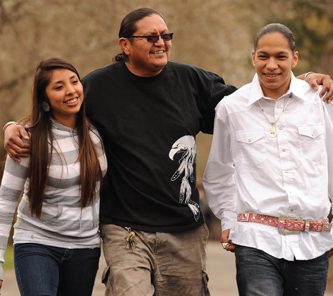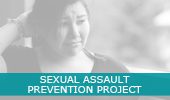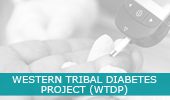Project Red Talon works to prevent human immunodeficiency virus (HIV), sexually transmitted infections (STIs) and Hepatitis C virus (HCV). The project has provided training and technical assistance to tribes and tribal organizations throughout the U.S. on implementing and evaluating culturally appropriate sexual health and STI/HIV prevention programs since 1988. The project is funded by the IHS HIV Program.

Goals
The primary goal of this project is to promote sexual health and wellness for AI/AN people by disseminating and implementing effective programs from a socio-ecological framework, addressing systems, communities, organizations, individuals and policies. The quality improvement project works with partners across the nation to:
- Improve STI/HIV/HCV testing, screening, treatment, and reporting practices within NW tribal clinics.
- Strengthen the capacity of tribal health educators, program managers, and clinicians to provide STI/HIV/HCV prevention services to their local community.
- Increase community awareness about SIT/HIV/HCV.
- Increase AI/AN representation in regional and national STI/HIV/HCV workgroups.
For over 26 years, Project Red Talon has provided training and technical assistance to the NW tribes on implementing and evaluating culturally appropriate STI/HIV prevention programs. The first STI/HIV prevention project at the NPAIHB started in 1988 with an AIDS Knowledge, Attitude, and Behavior (KAB) survey. This was followed by a CDC-funded HIV/STI prevention project. Over the years, NPAIHB has been instrumental, both regionally and nationally, in making HIV, HCV and STI prevention a priority issue at regional and national Indian health meetings. Other completed projects include:
Project Red Talon partnered with the Oregon Health Sciences University (OHSU) Prevention Research Center and a NW tribe to evaluate the delivery of the Native STAND curriculum and filmmaking training to a cohort of middle and high school students over a three-year period. Native STAND incorporates American Indian tradition and culture to address STI, HIV, and teen pregnancy, as well as drug and alcohol and dating violence.
The survey was completed in 2009 by 400 Native teens and young adults in the Pacific Northwest, to assess their use of the internet, social networking sites, and cell phones. Project Red Talon is now using this information to develop technology-based health resources for Native youth in the region.
To better understand the types of STI/HIV prevention services available to the NW tribes, Project Red Talon conducted a comprehensive Tribal STI/HIV Capacity and Readiness Assessment among tribes in Idaho, Oregon, and Washington in May 2005 and August 2006. Two survey tools were developed to encapsulate the various prevention efforts available at the clinic and community level. The results were published in the Red Talon STI Profile report.
The AI/AN HIV Testing Survey (HITS) was designed to assess the attitudes and behaviors of American Indians at high risk for HIV infection. To improve the survey’s culturally appropriateness, NPAIHB utilized AI/AN focus groups to modify the wording of questions and answer choices, and added questions about cultural practices that intentionally break the skin, such as ceremonial body piercing and tattooing (which may lead to HIV exposure). Two hundred and twenty two (222) surveys were administered in 2001 to AI/ANs residing in the Portland metropolitan area. This survey was repeated in 2002 with approximately 250 participants from two rural NW tribes.
The sexual health quality improvement project focuses on HIV, STI and Hepatitis C, and is starting to work on reproductive health and unplanned pregnancy. The project works closely with partners across the nation to improve clinical sexual health measures. Highly varied and relatively low screening rates for CT, HIV, HCV and other sexual health measures occur for a number of possible reasons, including but not limited to: differences in healthcare organizations, variation in processes, organizational climate and culture, human behavior and biases, and provider and patient knowledge. In order to effectively change and improve screening rates in clinical care settings, it is important to focus on how to improve the systems we have in place in which patients receive primary care. The quality improvement project works with participating sites to increase sexual health screening measures. The aim of this project is to promote sexual health and wellness for AI/AN people by effectively disseminating and implementing effective programs with a focused effort on improvement and implementation from a socio-ecological framework, including systems, communities, organizations, individuals and policies.
The Red Talon STI/HIV Coalition was active from 2005-2011. Tribal Action Plans were actively used by the NW tribes and partnering agencies to guide program planning, catalyze community outreach, and foster a coordinated response to STIs and HIV/AIDS in our tribal communities.
- The 2006-2008 Tribal Action Plan: Tribal Action Plan
NPAIHB Resolution - The 2009-2011 Tribal Action Plan: Tribal Action Plan | NPAIHB Resolution
In 2012, Project Red Talon and THRIVE established the NW Native Adolescent Health Alliance, an inclusive, multi-functional group that now meets quarterly to discuss cross-cutting planning and prevention strategies targeting AI/AN teens and young adults (addressing tobacco, substance abuse, STI/HIV, teen pregnancy, and suicide topics). Our goal is to support regional action planning, resource development, and sharing in OR, WA, and ID.
The Alliance is guided by a multidisciplinary Action Plan:
It has been recognized for some time that American Indians and Alaska Natives (AI/AN) are disproportionately impacted by high rates of HIV, HCV and sexually transmitted diseases (STIs). In 2011, the estimated rate (per 100,000 population) of HIV infection diagnoses among AI/AN males was greater (18.0) than the rate for white males (14.5). The rate per 100,000 population among AI/AN females was greater (5.5) than for white females (2.0). During 2002–2010, the incidence rate of acute hepatitis C remained below 0.5 cases per 100,000 for all racial/ethnic populations except AI/ANs. Rates for AI/ANs have been higher than for other races/ethnicities, especially in 2010 and 2011.
In 2015, the chlamydia rate for AI/AN was 709.1 cases per 100,000 population, 3.8 times the rate among Whites. On average, chlamydia rates were stable during 2011-2015. The gonorrhea rate increased by 71.3% among AI/AN from 2011-2015. In 2015 the gonorrhea rate was 192.8 cases per 100,000 population, which was 4.4 times the rate among Whites. There was also an increase (90.3%) of Primary & Secondary syphilis (P&S) for AI/AN during 2011-2015. In 2015, the P&S syphilis rate among AI/AN was 5.6 cases per 100,000 population, 1.4 times the rate among Whites. A 19.5% decrease of congenital syphilis rates was observed among AI/AN during 2014-2015. However rates are still 2.3 times the rate among Whites, with a rate of congenital syphilis of 10.3 cases per 100,000 live births among AI/AN.
Data Resources
- Indian Health Surveillance Report – Sexually Transmitted Diseases presents statistics and trends for STIs among AI/ANs in the United States: http://www.cdc.gov/STI/stats/IHS/default.htm
- HIV/AIDS among American Indians and Alaska Natives: http://www.cdc.gov/hiv/resources/factsheets/aian.htm
- IHS HIV/AIDS Statistics: https://www.ihs.gov/hivaids/stats/
- CDC STI Data and Statistics: http://www.cdc.gov/STI/stats/default.htm
- Health Disparities in HIV/AIDS, Viral Hepatitis, STIs: http://www.cdc.gov/nchhstp/healthdisparities/AmericanIndians.html
Sexual Health Social Marketing campaigns can be found on the Board’s media page.
Native It’s Your Game (IYG) is an evidence-based multimedia sexual health program for AI/AN youth 12-14 years old. The project is funded by the Centers for Disease Control and Prevention (CDC) and the Administration for Children and Families (ACF). More information can be found on the project page.
Native STAND is a comprehensive curriculum for Native high school students that promotes healthy decision making. The curriculum is highly interactive and skills-based, and focuses on STI/HIV and teen pregnancy prevention, while also covering drug and alcohol use, suicide, and dating violence. Sessions focus on positive personal development, including team building, diversity, self-esteem, goals and values, healthy decision making, negotiation and refusal skills, and effective communication. It was designed to train peer-educators in the 10th grade, but has been successfully used by Tribes in other settings and adapted for other grade levels.
- The curricula is available online at: http://oregonprc.org/projects/current/native-students-together-against-negative-decisions.html
- Native STAND was evaluated in 2009-2010 in four BIE Boarding Schools. The final report is available here: Native STAND Aggregate Report
- An article describing the process was published in 2011: Health Education Monograph
- Native STAND videos are available on YouTube: http://www.youtube.com/user/Nativestand7#p/u
The videos can be used in conjunction with the Native STAND curriculum, or on their own to prompt discussion with teens. A teacher’s guide for the videos is available here: Native STAND Teacher’s Guide
Native VOICES is a 23-minute, evidence-based video designed to prevent HIV and other sexually transmitted diseases. The video was designed to encourage condom use and improve condom negotiation skills among heterosexual and LGBTQ (Lesbian, Gay, Bisexual, Transgender and Queer) American Indian teens and young adults 15–24 years old. The culturally tailored video covers important sexual health topics, including: Talking to your partner about sex, STI testing, Defining and enforcing personal values, and Healthy relationships.
- Native VOICES is the first and only intervention purposefully designed for AI/AN youth included in the CDC’s compendium of effective HIV prevention interventions.
- The video can be accessed on YouTube: https://www.youtube.com/playlist?list=PLvLfi7yZ2zQFOVbQ6ErG0spR_GHK2dVNg
- Additional resources can be found on the project page.
School-Based Screening. Developed by the Indian Health Service STI Program, the manual provides ideas, checklists, case studies, and tools for tailoring a school-based screening project to the needs and resources available to your tribe.
- Starting a School-Based Chlamydia Screening Project in Indian Country: Download the guidelines
- Parent Q&A Booklet: Download the Booklet.
The IHS/CDC Screening Policy and Treatment Protocol is a collection of documents that can be used to guide the standard delivery of STI/HIV screening and treatment in I/T/U clinics.
- Sample Policy STI Screening and Treatment in AI-AN Populations
- Sample Protocol STI and HIV Screening, STI Treatment
- STI Screening Recommendations, 2010
- NCSD-NNPTC 2010 Treatment Guidelines
- Performing a Sexual Risk Assessment
- PDPT_Patients_Chlamydia + Gonorrhea
- PDPT_Partners_Chlamydia
- PDPT_Partners_Gonorrhea
The documents were produced by Cardea, in partnership with the Alaska Native Tribal Health Consortium; IHS National STI Program; JSI Research & Training Institute – Region VIII IPP; Project Red Talon at the Northwest Portland Area Indian Health Board; and the Phoenix Indian Medical Center.
The clinical practices included in the IHS/CDC Screening Policy and Treatment Protocol play an integral role in reducing STI/HIV transmission in our tribal communities. Please contact Project Red Talon for technical assistance or examples demonstrating how these policies have been successfully implemented other I/T/U settings. Your support and use of these policies are invaluable to the health of our communities.
Related Resources:
- CDC’s Sexually Transmitted Diseases Treatment Guidelines: http://www.cdc.gov/STI/treatment/
- CDC’s Expedited Partner Therapy Guidelines: http://www.cdc.gov/STI/ept/
- CDC’s Revised Recommendations for HIV Testing of Adults, Adolescents, and Pregnant Women in Health-Care Settings: http://www.cdc.gov/hiv/topics/testing/
- 2015 Northwest HIV/STI/HCV Treatment Practices and Training Needs Assessment: Profile Report PDF 2 MB
- World Indigenous Peoples’ Conference on Viral Hepatitis: Consensus Statement
- Patricia Yao, PhD, Rongwei Fu, PhD, Stephanie Craig Rushing, PhD, MPH, David Stephens, RN, Joan S. Ash, PhD, MBA, Karen B. Eden, PhDTexting 4 Sexual Health: Improving Attitudes, Intention, and Behavior Among American Indian and Alaska Native Youth Health Promotion Practice DOI: 10.1177/1524839918761872
- Craig Rushing, S., & Gardner, W. (2016). Native VOICES: Adapting a video-based sexual health intervention for American Indian teens and young adults using the ADAPT-ITT model. American Indian and Alaska Native Mental Health Research, 23(1), 24-46. See: http://www.ucdenver.edu/academics/colleges/PublicHealth/research/centers/CAIANH/journal/Pages/Volume23.aspx
- Markham, C. M., S. Craig Rushing, et al. “Factors Associated With Early Sexual Experience Among American Indian and Alaska Native Youth.” Journal of Adolescent Health 57(3): 334-341. DOI: 1016/j.jadohealth.2015.06.003
- Rushing, S. C., Gaston, A., Kaufman, C., Markham, C., Jessen, C., Gorman, G., Torres… (2015). Using Technology to Promote Health and Wellbeing among American Indian and Alaska Native Teens and Young Adults. Indigenous People and Mobile Technologies. Routledge Press.
- Gemelas J, Locker R, Rudd S, Prevost C, Reilley B, Leston J. (2015) Impact of Screening Recommendations for the Identification of Chronic Hepatitis C Virus Infection Among Persons Born During 1945-1965: A Primary Care Case Study.
- Reilley B, Leston J, Tulloch S, Neel L, Galope M, Taylor M. (2015) Implementation of National HIV Screening Recommendations in the Indian Health Service. Journal of the International Association of Providers of AIDS Care. February 2015.
- Desiderio, G., Garrido, M., Martínez García, G., and Eisler, A. (2014). Lessons Learned in Providing Health Care Services for Native Youth. Baltimore: Healthy Teen Network.Download Report
- Rushing, S. C., Canniff, B., Gardner, W., Hoopes, M., Warren-Mears, V., & Left Hand Bull, J. (2014). Primary Prevention with American Indians and Alaska Natives. In Gullotta, T. P. & Bloom, M. (Eds.), Encyclopedia of Primary Prevention and Health Promotion. (2nd ed.). Heidelberg: Springer. pp 480-489.DOI: 1007/978-1-4614-5999-6_330
- Reilley B, Leston J, Redd JT, Geiger R. (2014) Lack of Access to Treatment as a Barrier to HCV Screening: A Facility-Based Assessment in the Indian Health Service. Journal of Public Health Management and Practice. July 2014.
- Leston, J, Reilley B. (2014) Screening for HIV, Chlamydia, and Hepatitis C: Improvement and Lessons Learned from 2010 to Present. IHS Primary Care Provider. April 2014.
- Onders R, Spillane J, Reilley B, Leston J. (2014) Use of Electronic Clinical Reminders to Increase Preventative Screenings in a Primary Care Setting: Blueprint from a Successful Process in Kodiak, AK. Journal of Primary Care and Community Health. January 2014.
- Rudd S, Gemelas J, Reilley B, Leston J, Tulloch S. (2013) Integrating Clinical Decision Support to Increase HIV and Chlamydia Screening. Preventative Medicine. December 2013.
- Gardner, W., & Craig Rushing, S. (2013). Native VOICES: Developing an evidence-based HIV/STI intervention for Native teens and young adults. The IHS Primary Care Provider: Vol. 38, No 4: 74.
- Leston, J., & Craig Rushing, S. (2012). WE R NATIVE: A Multimedia Health Resource for Native Teens and Young Adults. The IHS Primary Care Provider: Vol. 37, No 4: 101.
- Craig Rushing, S., & Stephens, D. (2012). Tribal recommendations for designing culturally appropriate technology-based sexual health interventions targeting Native youth in the Pacific Northwest. American Indian and Alaska Native Mental Health Research, 19(1), 76-101. Available at: http://www.ucdenver.edu/academics/colleges/PublicHealth/research/centers/CAIANH/journal/Pages/Volume19.aspx.
- Craig Rushing, S., Stephens D., Leston, J., and Gardner, W. (Spring/Summer 2011). Surfing and Texting for Health: Media Use and Health Promotion Targeting NW Native Youth. NW Public Health Journal. Vol. 28. No. 1: p 16-17. Download the Article
- Smith M and Craig Rushing SN. (2011). Native STAND (Students Together Against Negative Decisions): Evaluating a School-Based Sexual Rush Reduction Intervention in Indian Boarding Schools. Health Education Monograph Series. Vol. 28, No 2: 67-74. Download the Article
- Craig Rushing, SN and Stephens, D. (2011). Use of Media Technologies by Native American Teens and Young Adults in the Pacific Northwest: Exploring their Utility for Designing Culturally-Appropriate Technology-Based Health Interventions. Journal of Primary Prevention. DOI: 10.1007/s10935-011-0242-z. Download the Article
- Stopping the Silence: Program Opens Lines of Communication to Cut STI Rate Among Native Americans. Tim Weldon. The Council of State Governments, Vol. 51, No. 3. March 2008.
Download the Article - Project Red Talon: Health care professionals, communities benefit from coalition’s HIV/STI training. Babette Herrmann. Indian Country Today. December 19, 2007.
Download the Article - Within the Hidden Epidemic: Sexually Transmitted Diseases and HIV/AIDS among American Indians and Alaska Natives. Kaufman CE, Shelby L, Mosure DJ, Marrazzo J, Wong D, de Ravello L, Craig Rushing S, Warren-Mears V, Neel L, Jumping Eagle S, Tulloch S, Romero F, Patrick S, Cheek J. Sexually Transmitted Diseases (May 2007).
Download Report - HIV-related risk behaviors, perceptions of risk, HIV testing, and exposure to prevention methods among urban American Indians and Alaska Natives. Lapidus J, Bertolli J, McGowan K, Sullivan P. (2006). AIDS Education and Prevention 18(6), 546-559.
Download Report - Sexually transmitted diseases among American Indians and Alaska Natives in Washington State, 1995-2000. Puuka E, Jackson S, Stehr-Green P. (n.d.) Northwest Tribal Epidemiology Center, Northwest Portland American Indian Health Board. Download Report
The NW AIDS Education and Training Center offers an extensive HIV Web Study
(See: http://depts.washington.edu/hivaids/). The website features over 60 interactive case studies that cover a broad array of topics related to the clinical care of HIV-infected persons. Each topic includes case studies, discussion points, high-quality illustrations, and graphics, references, and links. The site also offers free CME credit.
University of Washington offers Hepatitis C online training modules for CE credit, from screening and diagnosis to treatment: http://www.hepatitisc.uw.edu/alternate
The Seattle STI/HIV Prevention Training Center offers a variety of STI/HIV trainings and preceptorships throughout the Northwest: http://depts.washington.edu/seaptc/course_list.shtml
The Indian Health Service HIV Program has links to several training resources: http://www.ihs.gov/hivaids/index.cfm?module=training Their Online Training Modules are aimed at “increasing the awareness, knowledge, and skills of providers; AI/AN people living with HIV/AIDS; and community members interested in learning about HIV”: http://www.ihs.gov/hivaids/toolkit/ihs_toolkit_people_menu.htm
Be Safe. An AI/AN HIV Cultural Competence Model is available through the National Minority AIDS Education and Training Center (NMAETC) or: Download the Model
HIV Prevention, Early Intervention and Health Promotion: A Self Study Module for Health Care Personnel Serving Native Americans. Available through the Mountain-Plains AIDS Education and Training Center (MPAETC) or: Download the Study Module














